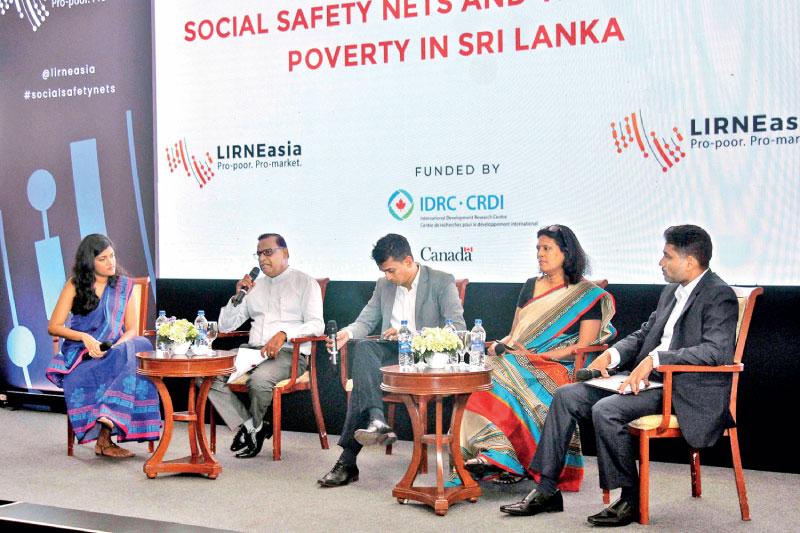Reply To:
Name - Reply Comment

Panel discussion underway on the new survey findings of ‘Social Safety Nets and the State of Poverty in Sri Lanka’ - PIC BY NISAL BADUGE
By Shabiya Ali Ahlam
As Sri Lanka is looking to support the poor and vulnerable population, which has significantly expanded since the pandemic and economic crisis, Colombo-based policy think tank LIRNEasia urged the government to reopen the registration of the new welfare scheme ‘Aswesuma’, so that the right candidates are captured in the system.
A survey carried out across 400 Grama Niladhari divisions showed that a significant proportion of the poor and vulnerable community across the country has not registered for the upcoming scheme, as they have not received the right information.
According to the survey, despite the scheme being advertised via multiple channels such as print media, electronic media, SMS, loudspeakers and via government officials, there is lack of awareness within the target population about the scheme.
The respondents, specially at the estate sector worker level, alleged that the news is selectively shared by those in charge of the Samurdhi scheme with those who are closest to them.
Meanwhile, a portion of the target population opted not to register for the scheme, as they shared that they did not trust the government and its capability in rolling out the scheme in a fair and transparent manner, as they were unable to obtain benefits in the past, despite being eligible.
Under the Samurdhi scheme, about 1.7 million families received monthly cash transfers, while in reality, only 40 percent of that group was said to be eligible for the scheme.
The findings by LIRNEasia revealed that only 31 percent of the poorest 10 percent of households received the benefits from the scheme, while 4 percent of the wealthiest 10 percent of households too were in the system.
The survey findings also showed that with the previous welfare schemes, the officials exercised high discretion when determining the eligibility and the programmes were co-opted for political gains.
Further, the limited and opaque pathways to exit the welfare schemes in place made it difficult for the ‘new’ poor and vulnerable communities to be incorporated into the system.
LIRNEasia shared that only 17 percent of those who have received the welfare benefits exited the programme in Sri Lanka, which is significantly lower when compared with similar schemes implemented in Bangladesh (40 percent), Mexico (30 percent), Zambia (25 percent) and Colombia (45 percent).
LIRNEasia stressed the need to reopen and keep registration open for Aswesuma, so that those who might fall into the vulnerable category going forward would be able to fall onto the safety net. It also highlighted the need to improve communication on registrations.
“Incentive officials must engage in outreach beyond their circles and look to highlight to those who feel they are in need that they can apply for the scheme,” the policy think tank said.
It also recommended the need to provide digitally-enabled registration options, similar to the schemes implemented by many South Asian countries.Further, the government must also explore low-tech options such as SMS-based registration, as 92 percent of poor households own a mobile phone. This is the most common method of applying for benefits in South Africa.
The think tank acknowledged that the new scheme signals that graduation from social assistance is a priority, thus making it imperative to provide access to credit and access to capacity-building programmes.